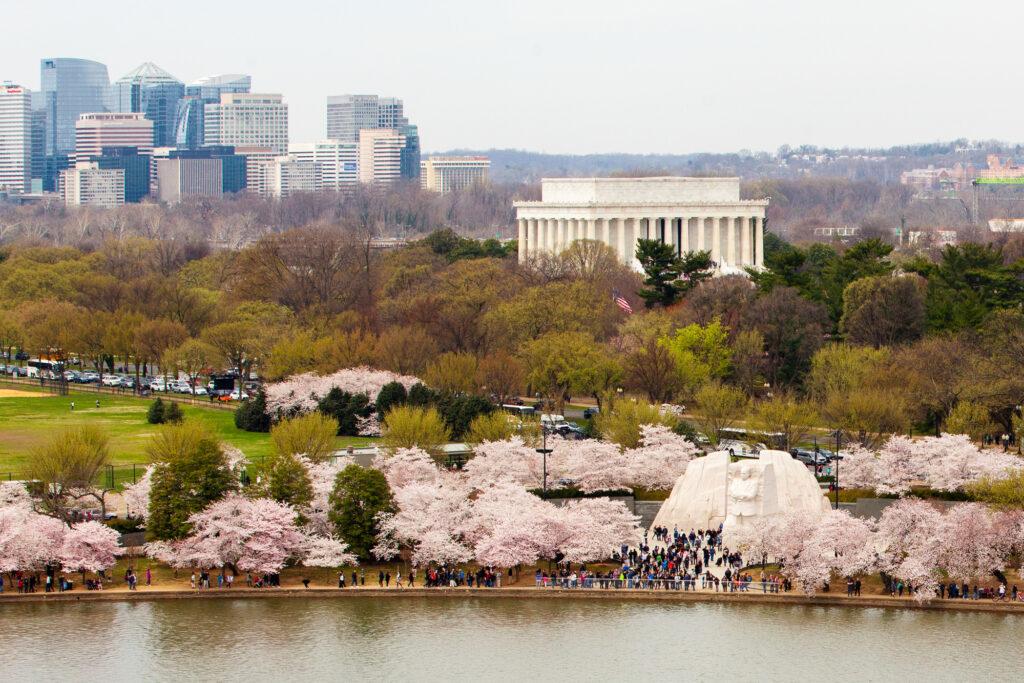In recent weeks, Washington, D.C., has seen an earlier blooming of cherry blossoms compared to past years. Records show that over time, the trees have opened their buds earlier and earlier, a trend that is expected to continue for the heavily touristed Tidal Basin cherry blossoms in southwest D.C.
The 2023 Peak Bloom Forecast cites a “much warmer-than-normal January” and February as the likely cause of this divergence from the normal blooming time, which ranges from the last week of March to the first week of April. This year, peak bloom is predicted to last from March 22 to 25. The weather in early March will also have a crucial impact on this timeline, but climate change driving intense fluctuations in weather has left the future more unpredictable than ever.

D.C.’s recent weather has served as a prime example of the varying temperatures and warmer winter. The District set a new record of 81 degrees for its highest temperature ever recorded on Feb. 23, surpassing the previous record of 78 degrees, which had been held since 1874. The District saw snowfall and a high of only 50.6 degrees two days later on Feb. 25.
Although increases in temperature may appear to be the only evidence of “global warming,” cold snaps are also an indicator of the weather impacts of climate change. Climate change pertains to a diversification and intensification of the climate, not just temperature increases due to the accumulation of greenhouse gasses in the atmosphere.
According to Gina Green, a professor of the practice at Georgetown’s Earth Commons Institute, this phenomenon may be due to La Nina, a climate phenomenon dictated by oceanic and atmospheric patterns in the Pacific Ocean that pushes the polar jet stream north, creating warmer winters for the District.
“Climate change has always been predicted to create this significant variability in temperature, without a shadow of a doubt,” Green told The Hoya. “Because of the La Niña current, we don’t have a significant winter by any means.”
Unfortunately, this connection between weather and the environment has far more potential for damage than just the cherry blossoms. An overall lack of snowpack throughout the winter season likely means that the soil is drier than what this environment usually experiences.
“What does that mean for our rivers and what does that mean for water flow and what does that mean for potable water to drink?” Green said. “The other impact could be wildfires, now that there’s much more dryness in the soil and in the trees so the trees become much more vulnerable.”
The potential for wildfires due to this drier environment is a first-time concern in the D.C. area—and are part of what Green labels “non-visual” symptoms of climate change.
“Two days ago it was 80 degrees and today it’s snowing,” Green said. “What impact does this have on the birds? Does this mean crops will fail? Does this mean our tulips or our flowers will fail? Collectively, we can come up with those answers.”
These symptoms are less tangible in contrast to the earlier blooming of the cherry blossoms, allowing them to slide under the radar, according to Green.
For example, anyone strolling around the Georgetown campus last Thursday would have thought they had just stumbled into a college brochure: Spikeball games on the lawn, students dressed in their best summer attire and gorgeous cherry blossoms hanging overhead. However, as beautiful as the day was, a sentiment of “what is going on here?” loomed, according to Georgetown student Ina QC (SFS ’24).
“I think the quick changes and fluctuations in temperatures might upset our natural rhythms, like adding additional uncertainty into the day to day lives of college students, which will only add to our stress,” QC told The Hoya. “The one thing we can be sure of and rely on are the seasons. This lack of consistency might feed into existing anxieties honestly.”
Instead of seeing the change as a herald of doomsday, Green said it is important to emphasize the importance of positivity and hope in the fight against climate change.
“I am such an optimist, not a pessimist, but I do believe that we have to innovate,” Green said. “We are now feeling the impacts of climate, right here in this area, but when you emit carbon it impacts globally. That’s where collective action needs to take place.”








